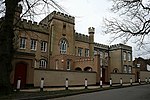Priest Hill
Surrey Wildlife Trust

Priest Hill is a 35-hectare (86-acre) nature reserve on the eastern outskirts of Epsom in Surrey. It is managed by the Surrey Wildlife Trust.More than 1,500 tons of tarmac and rubble were cleared from these former playing fields to create a grassland nature reserve. Three ponds have been created and green hay from another reserve has been spread over some areas to introduce the seeds of wild flowers such as kidney vetch.There is access from Reigate Road and Banstead Road. Some areas are closed to the public.
Excerpt from the Wikipedia article Priest Hill (License: CC BY-SA 3.0, Authors, Images).Priest Hill
Priest Hill Close, Epsom and Ewell
Geographical coordinates (GPS) Address Nearby Places Show on map
Geographical coordinates (GPS)
| Latitude | Longitude |
|---|---|
| N 51.339 ° | E -0.236 ° |
Address
Priest Hill Close
KT17 3FD Epsom and Ewell
England, United Kingdom
Open on Google Maps








